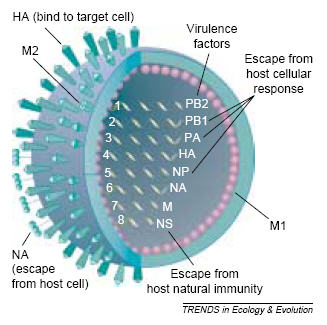Influenza
Influenza (flu) is a respiratory infection in mammals and birds. It is caused by an RNA virus in the family Orthomyxoviridae.
The virus is divided into three main types (A, B and C), which are distinguished by differences in two major internal proteins.

Influenza virus type A is the most significant epidemiologically and the most interesting from an ecological and evolutionary standpoint, because it is found in a wide variety of bird and mammal species and can undergo major shifts in immunological properties. Type B is largely confined to humans and is an important cause of morbidity. Little is known about type C, which is not an important source of morbidity. Influenza A is further divided into subtypes based on differences in the membrane proteins hemagglutinin (HA) and neuraminidase (NA), which are the most important targets for the immune system. The notation HhNn is used to refer to the subtype comprising the hth discovered HA protein and the nth discovered NA protein. There are currently two subtypes circulating in humans: H1N1 and H3N2. Subtypes are further divided into strains; each genetically distinct virus isolate is usually considered to be a separate strain.